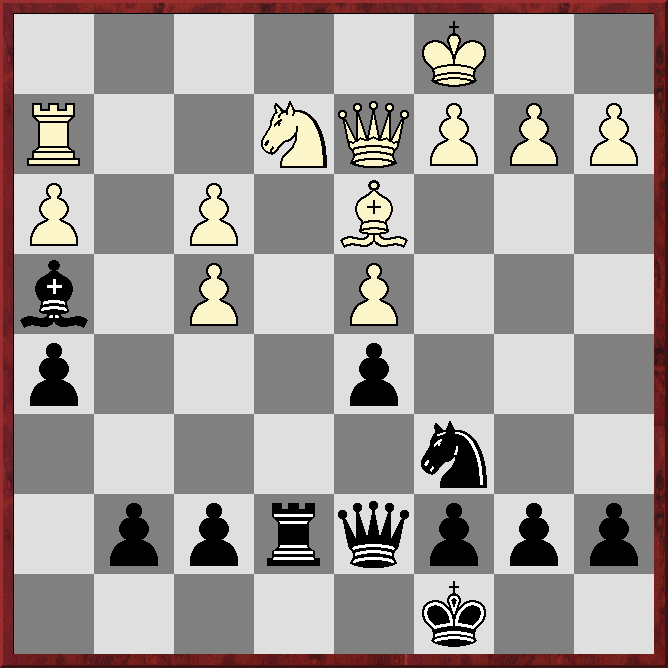The building looks impressive from outside, and the interior, complete with a bar, does not disappoint.
The only downside is that the games were played on bridge tables that did not have enough room for scoresheets.
Spanton (2040) - Richard J McMichael (FM 2261)
London League, Battersea 2 - Kings Head
Board One (of eight)
French 3...Nc6
1.Nc3 e6 2.d4 d5 3.e4 Nc6!?
White scores 54% after this move in ChessBase's 2022 Mega database - less than for the more-popular 3...dxe4 (White scores 62%), 3...Nf6 (55%) and 3...Bb4 (also 55%). If the variation has a name, I do not know it, although early proponents include James Mason (scored +0=2-1 in Mega22), Semyon Alapin (+3=1-0) and Aron Nimzowitsch (+4=1-0).
4.exd5!?
More popular, and probably more challenging for Black, are 4.Nf3 and 4.e5.
4...exd5 5.Nf3 Bg4 6.h3!?
Provocative.
6...Bxf3
*****
*****
*****
*****
7.gxf3?!
Gaining the bishop-pair almost certainly does not fully compensate for White's multiple kingside weaknesses. My main analysis engines Stockfish14.1 and Komodo12.1.1 give 7.Qxf3 Nxd4 8.Qd3, when the game David Paravyan (2653) - Anatoliy Polivanov (2452), PNWCC Online Blitz, continued 8...c5 9.Be3 Nf6 10.0-0-0, which the engines reckon is very good for White (1-0, 26 moves). They suggest Black gives back the pawn immediately with 8...Ne6 9.Nxd5 Bc5, when White may have a slight pull.
7...Be7 8.Be3 Bf6 9.Qd2 Nge7 10.0-0-0 Nf5 11.Bd3!?
*****
*****
*****
*****
11...Qd7
It seems Black can safely grab the d pawn, eg 11...Nfxd4!? 12.Bxd4 Nxd4 13.Rhe1+ Kf8, when Black has lost castling rights but is winning, according to the engines. They prefer the sharp 12.Bf1!? Qd6 13.Bxd4 Nxd4 15.Qe3+ Ne6 16.Nxd5 Bg5 17.f4 Qxd5 18.Rxd5 Bxf4 19.Qxf4 Nxf4 20.Re5+ Ne6, when White has the better minor piece but is again a pawn down.
It seems Black can safely grab the d pawn, eg 11...Nfxd4!? 12.Bxd4 Nxd4 13.Rhe1+ Kf8, when Black has lost castling rights but is winning, according to the engines. They prefer the sharp 12.Bf1!? Qd6 13.Bxd4 Nxd4 15.Qe3+ Ne6 16.Nxd5 Bg5 17.f4 Qxd5 18.Rxd5 Bxf4 19.Qxf4 Nxf4 20.Re5+ Ne6, when White has the better minor piece but is again a pawn down.
12.Rde1?!
Probably too slow. The engines reckon White equalises with 12.Bg5!, when best seems to be 12...0-0-0 13.Bxf6 gxf6 14.Bb5 as 12...Be7 13.Bxf5 Qxf5 14.Bxe7 Nxe7 15.Rde1 favours, if anyone, White.
12...0-0-0 13.Bb5 Nh4 14.Be2 Qf5 15.f4 h5
Not 15...Rhe8?? 16.Bg4.
16.f3?
This weakens e3, which is more important than the gain of covering e4. Much better is seeking queenside counterplay with 16.Na4, eg the plausible 16...Rhe8 is met by 17.Nc5, threatening to win with 18.Bd3. The engines suggest 16...Be7, when 17.Nc5?? loses to 17...Bxc5 18.dxc5 d4, so White should probably play 17.c3, albeit Black is better.
16...Rhe8 17.Rh2 Re7 18.Bf2 Rde8 19.Bd3
*****
*****
*****
*****
19...Qd7
Black is better after this but the engines point out the hair-raising but convincing 19...Rxe1+ 20.Bxe1 Rxe1+! 21.Qxe1 Qxf4+ 22.Rd2 Nxf3 23.Nxd5 Qg5! 24.Qe8+ Nd8 25.Ne3 Nxd2 26.Kxd2 Bxd4, when Black emerges two pawns up.
20.Bxh4 Bxh4 21.Rxe7 Rxe7 22.Ne2
*****
*****
*****
*****
22...Qe6
22...Qe6
Not 22...Nxd4?? 23.Nxd4 Re1+ 24.Qxe1 Bxe1 as White has 25.Bf5. But stronger than the text is 22...Qd6! as then ...Nxd4 is a threat, and if 23.c3 Black has 23...Bg5!?
23.c3 Qe3 24.Rg2 g6
*****
*****
*****
*****
25.Ng1?!
Rather than this passive defence, White has two promising lines. One is 25.Kc2!?, when it is hard to see how Black can make progress as 25...Qxf3 26.Ng1 Qe3 27.f5 probably favours White. The other is the immediate 25.f5!?, when 25...Qxf3? 26,Ng1 is good for White, so Black should probably play 25...g5, eg 26.f6 Re8 27.Qxe3 Rxe3 28.Bf5+ Kd8, which the engines reckon is equal.
25...Qe6?!
Black seems slightly better after both 25...Qe1+ 26.Qxe1 Rxe1 27.Kd2 Ne7 and 25...Be1 26.Qxe3 Rxe3.
26.Re2
The engines give 26.f5!?, when they reckon 26...gxf5 27.Kc2 is better for White, eg 27...Qf6 28.Rg8+ Kd7 29.Qf4 with an initiative. Better, according to the engines, is 26...Qd7!? but then 28.fxg6 fxg6 29.Qf4 g5 30.Qf6 seems to favour White (but not 29.Rxg6? Re1+ 30.Kc2 Ne7 as Black has the devastating follow-up ...Qa4+).
26...Qf6 27.Rxe7 Nxe7 28.Qe3 g5 29.Qe5 Qxf4+ 30.Qxf4 gxf4
*****
*****
*****
*****
Black's extra pawn is doubled and isolated, and Black has to be wary of allowing the knights to come off and so allowing a drawish opposite-coloured bishops ending. However Black has more space on the kingside, and targets in White's isolated f and h pawns. The engines reckon Black has the upper hand.
31.Kd2 Bf2 32.Ne2 Be3+ 33.Kd1 Kd7 34.Nc1 Bxc1
This gets rid of the worry of a drawn opposite-coloured bishops ending, and conforms with the general rule that pieces of a different type usually help the side pushing for a win in an ending. There is also the point that the white bishop cannot easily get at the black pawns.
35.Kxc1 Ke6 36.Kd2 Kf6 37.Ke2 Ng6 38.Kf2
Stockfish14.1 (but not Komodo12.1.1) gives 38.Bxg6?! fxg6 39.h4.
38...Kg5 39.Bc2 Nf8 40.Bb3 c6 41.Bc2 Ne6 42.Bd3 b6 43.Bb7 Kf6 44.Bb7 Nd8 45.Bc8 c5!?
Exchanges on the queenside will give Black's king the chance to penetrate the white position.
46.dxc5 bxc5 47.b4!?
Hoping to create a queenside passer. White is lost in any case.
47...cxb4 48.cxb4 Ke5 49.Ke2 Kd4 50.Ba6 Kc3 51.a3 Ne6
Also winning is 51...Kb3!? but there is no need to decentralise the king.
The game finished:
52.Bb7 d4 53.Ba6 d3+!? 54.Kd1 (54.Bxd3 Nd4+ etc) Nd4 55.Bb7 Nc2 0-1
Kings Head defaulted on the bottom two boards, but won the match 4.5-3.5.
Kings Head defaulted on the bottom two boards, but won the match 4.5-3.5.






No comments:
Post a Comment